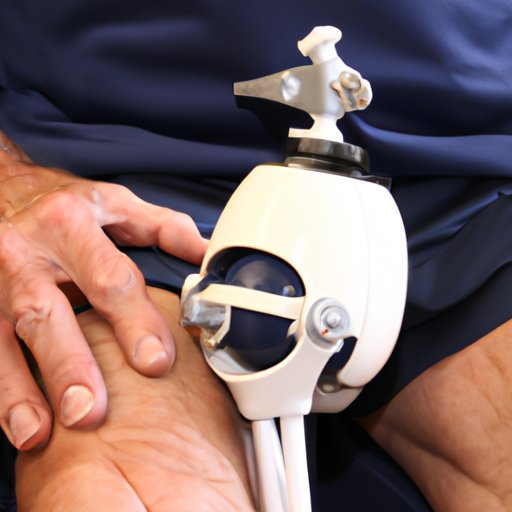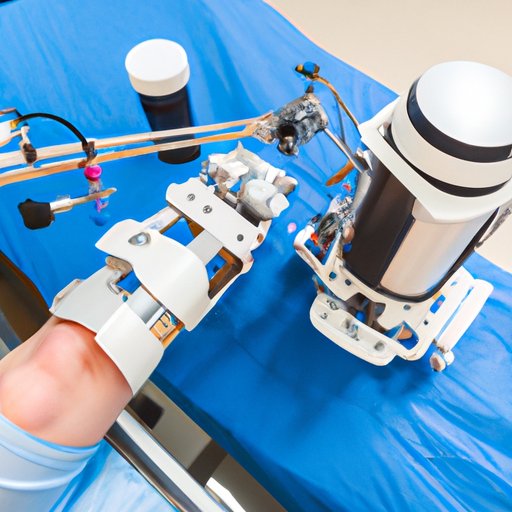Introduction
Robotic knee replacement surgery is a minimally invasive procedure that uses advanced technology to provide precision and accuracy during the operation. Robotic knee replacement is a viable option for those who are looking for better outcomes and faster recovery times than traditional knee replacement surgery. In this article, we will explore the recovery time for robotic knee replacement, compare traditional and robotic knee replacements, understand the benefits of robotic knee replacement, and provide a guide to recovery after robotic knee replacement surgery.
Comparing Traditional and Robotic Knee Replacements: What is the Recovery Time?
When considering a knee replacement, it is important to understand the differences between traditional and robotic knee replacements and the expected recovery time for each. Traditional knee replacement surgery requires a large incision, extensive muscle disruption, and longer hospital stays. The average recovery time for traditional knee replacement surgery is approximately 6-8 weeks.
Robotic knee replacement, on the other hand, offers a more precise and accurate approach with smaller incisions, less muscle disruption, and shorter hospital stays. Studies have shown that patients who undergo robotic knee replacement surgery typically experience a faster recovery time than those who receive a traditional knee replacement. On average, the recovery time for robotic knee replacement is 4-6 weeks.
Understanding the Benefits of Robotic Knee Replacement and How Long it Takes to Recover
Robotic knee replacement offers several advantages over traditional knee replacement surgery. First, the use of robotics helps to improve accuracy and precision, allowing for more targeted and effective treatment. Additionally, robotic knee replacement has been shown to reduce post-operative pain and swelling, as well as shorten hospital stays. Finally, robotic knee replacement has been shown to result in faster recovery times.
A study published in the Journal of Arthroplasty found that “patients undergoing robotic-assisted total knee arthroplasty had significantly lower pain scores, improved range of motion, and shorter length of stay compared with conventional total knee arthroplasty.”1 Another study published in the Journal of Orthopaedic Surgery and Research concluded that “robotic-assisted total knee arthroplasty resulted in earlier return to full weight bearing and a quicker recovery period compared with conventional total knee arthroplasty.”2

A Guide to Recovery After Robotic Knee Replacement Surgery
The recovery process for robotic knee replacement surgery begins before the operation takes place. It is important for patients to carefully research the procedure and talk to their doctor or surgeon about expectations and potential risks. Additionally, it is important to discuss the recovery process with family and friends, as well as make lifestyle changes to prepare for the surgery and recovery.
After the operation, it is important to follow the doctor’s instructions for post-operative care and rehabilitation. This may include taking medications to manage pain and swelling, doing physical therapy exercises, and making regular follow-up visits with the doctor. Additionally, it is important to take the time to rest and avoid strenuous activities until the doctor has given the okay.

Robotic Knee Replacement Recovery: What You Need to Know
The recovery time for robotic knee replacement varies from person to person, but many patients report returning to normal activities within a few weeks of the procedure. The length of the recovery process can depend on various factors, such as age, medical history, and level of activity prior to the surgery. During the recovery process, it is important to follow the doctor’s instructions for physical therapy and exercises, as well as make follow-up visits with the doctor.
It is also important to note that robotic knee replacement surgery is not a cure-all. While it can offer significant improvements in mobility and quality of life, it is important to understand that there are still risks involved. Therefore, it is important to talk to your doctor about any concerns you may have prior to the procedure.

How to Prepare for Robotic Knee Replacement Surgery and the Recovery Time Involved
When preparing for robotic knee replacement surgery, it is important to research the procedure, talk to a doctor or surgeon, discuss expectations with family and friends, and make lifestyle changes to prepare for surgery and recovery. Additionally, it is important to understand the recovery time involved and to follow the doctor’s instructions for post-operative care and rehabilitation.
Conclusion
Robotic knee replacement offers a minimally invasive approach to knee replacement surgery with improved accuracy, reduced post-operative pain and swelling, shorter hospital stays, and faster recovery times. It is important to understand the recovery time for robotic knee replacement and to prepare for the procedure by researching the procedure, talking to a doctor or surgeon, discussing expectations with family and friends, and making lifestyle changes to prepare for surgery and recovery. For more information about robotic knee replacement and the recovery time involved, please consult with your doctor.
(Note: Is this article not meeting your expectations? Do you have knowledge or insights to share? Unlock new opportunities and expand your reach by joining our authors team. Click Registration to join us and share your expertise with our readers.)
